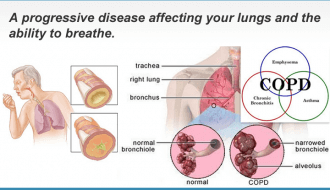Understanding and Coping with COPD
- Category: Blog
- Posted On:
- Written By: Tamara Magill

It is important to understand what goes on in your lungs in order to better control your breathing. Here is a start… the air we breathe contains about 21percent oxygen. When you breathe in either through your nose or mouth, air enters your body. The upper airway warms, humidifies and filters the air you breathe in. The air then travels down through the trachea (windpipe), in the bronchi (airways) and into the lungs.
At the end of the bronchi are a cluster of alveoli (balloons or air sacs). A healthy adult lung contains approximately 300 million alveoli! The walls of the alveoli are thin, like a soap bubble, to allow the oxygen to travel through it and into the bloodstream, where it is carried throughout your body. It’s important to know that oxygen provides you the necessary fuel not only to move throughout the day, but to keep your body alive.
After your body uses the oxygen, it turns into carbon dioxide, which is exhaled out of the body either through your nose or mouth. Cigarette smoke and air pollutants cause the airways to become swollen and narrowed. The lungs should be elastic and have the ability to stretch and then return back to their normal size. Smoking causes your lungs to lose their elasticity and get big and floppy, making it difficult to exhale the air out of the lungs.
When diagnosed with Chronic Obstructive Pulmonary Disease (COPD), you may feel both frightened and relieved to finally know what’s been going on with your breathing. Some people immediately want to learn everything they can about COPD in the hope of gaining control over the disease. Others choose a slower approach, learning bits and pieces, letting it sink in and asking a lot of questions.
In either case, you may experience various emotions dealing with COPD. The most common are depression, anxiety, and panic when you have shortness of breath. No doubt about it, it can be frightening when you lose your breath and it becomes difficult to do even simple daily activities. These feelings are completely normal, so don’t feel embarrassed or ashamed about them. With 24 million Americans suffering from COPD, you are definitely not alone.
There’s help. Here are some useful tips:
- Tell your doctor if you become anxious or depressed.
- Take control by learning about COPD, its effect on your lungs and proper techniques that help control your breathing.
- Ask your doctor if you are a candidate for Pulmonary Rehabilitation. Talk with others in the Pulmonary Rehabilitation program or other COPD support group, you’ll learn from respiratory therapists, share concerns and ideas and find encouragement from other participants.
- Most important … stay active! You may not be able to do some of the things you used to do, but it shouldn’t stop you from doing everything. By exercising and staying active, you improve your overall health, strength, flexibility and emotional wellbeing.
For more information, visit: www.copdfoundation.org.



